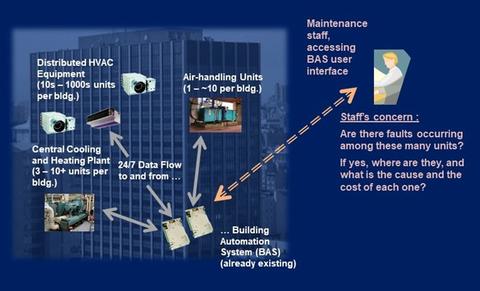Automated Fault Detection and Diagnostics for the Mechanical Services in Commercial Buildings
Summary
NIST is working to meet an industry need to measure and improve the operational performance and cost-efficiency of large commercial buildings by leveraging previously untapped capabilities of the automation and control systems already in those buildings. The improvements require a new, state-of-the-art measurement science employing artificial intelligence, machine learning, and statistical analysis to automatically detect and diagnose unwanted operating conditions (“faults”) that waste significant amounts of energy during daily operation of the mechanical (e.g., heating, ventilation, and air-conditioning (HVAC)) systems in such buildings.
The monetary costs building owners bear from fault-related waste are great enough that the sector of U.S. industry engaged with the operation and maintenance of large commercial buildings has spent over twenty years seeking a marketed technology that adequately addresses the problem. The widely dispersed scale and complexity of the HVAC system in a typical large building compels the market to offer highly automated fault detection and diagnosis (AFDD) software autonomously delivering a detailed yet comprehensive “24/7” fault surveillance that no maintenance staff of reasonable size could possibly conduct on its own. AFDD software further provides an expert diagnosis of the underlying (“root”) cause of each fault, helping maintenance staff ensure that buildings perform cost-effectively and efficiently.
However, research and development that is both ongoing and transferrable to commercial products is necessary to see transformative theoretical ideas, particularly from universities, become newly practical additions to the AFDD marketplace. That sort of research and development itself requires specialized AFDD software, a kind distinct from those typically deployed commercially for end-use in buildings. This project establishes a public, open-source implementation of such a specialized AFDD software, making it the basis of an ongoing, collaborative project by which a broad, open community of NIST and academic researchers, business-sector product developers, and individuals can experiment with novel ideas for AFDD and contribute their work to its marketable advancement.
Description

Objective
To put forward a new and practical measurement science whose “instruments” are realized commercially as a marketplace of highly effective, automated fault detection and diagnostic (AFDD) software products and services. These will employ data analytics and artificial intelligence to autonomously detect and diagnose faulty, wasteful conditions in the mechanical systems of large commercial buildings.
How is the objective being accomplished?
Accomplishing the project objective began with a cross–disciplinary mix of expertise in artificial intelligence, the thermodynamics and fluid mechanics of HVAC processes under surveillance, and the skills to conceive and implement that blended expertise into a NIST-founded, collaborative open-source software (OSS) project named ZandrEA™.
The ZandrEA project offers researchers from NIST, from academia, and from private-sector business a way to collaborate in developing extensible, scalable cutting-edge AFDD software applications able to run on both local and cloud-based computing platforms. ZandrEA will help its industry partners accelerate their development and marketing of new, highly capable products and services, as already demanded by building owners. Certain problems that commercial AFDD vendors experience in the performance of their products or services stem not from a lack of time and effort investment on their part, but from the lack of a targeted AFDD innovation sourced and developed from NIST and university research. NIST is currently using the ZandrEA project software to address such a situation with one cooperative research and development agreement (CRADA) industrial partner. The technical depth of this current research and development collaboration with an industrial partner is unprecedented for this project. It will serve as a guide and experience base for future technology transfers from NIST research and the ZandrEA project to the commercial sector of AFDD products and services.
What are the near-term goals?
NIST will enhance the relevancy and transferability of its proven expertise in applying and automating sophisticated artificial intelligence methods to AFDD. That effort began within NIST by building a new competency in formulating and expressing AFDD methods as ZandrEA components. They are modular, serviceable, technically extensible object–oriented program (OOP) software components fitting within the ZandrEA framework. They are intended to be transferable to industry by following software design practices used by industry in making innovative, marketable products and services.
Testing with ZandrEA collaborators or CRADA partners will include both web-based and cloud-based AFDD environments. Field test results will be used to improve the performance of the underlying artificial intelligence methods and identify any needed additional capabilities or features.
Expected future work includes reliability enhancements aimed at robustness to spurious data, prioritizing for the building staff the economic impact of faults found, and enhancing autonomy by replacing some queries of the user for diagnostic information with direct references to new knowledge base elements.
Major Accomplishments
Recent accomplishments for the Automated Fault Detection and Diagnostics for the Mechanical Services in Commercial Buildings:
- Public availability of the ZandrEA open-source AFDD software development site at https://github.com/usnistgov/ZandrEA
- Ongoing cooperative research and development agreement (CRADA) with a venture-capitalized U.S. tech industry partner engaged in AFDD for large commercial buildings

